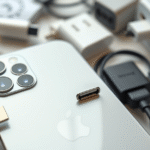Smart Doorbell technology is on the verge of a significant transformation as Apple enters the market with its innovative approach.
By integrating Face ID technology, this upcoming device aims to redefine home security for homeowners.
With facial recognition capabilities akin to iPhones, users will enjoy enhanced convenience and safety.
The focus on privacy and seamless integration into existing smart home systems sets this device apart from its competitors, particularly Amazon’s Ring.
Anticipated for release by the end of 2025, Apple’s smart doorbell promises to revolutionize the way we secure our homes and interact with our living environments.
A New Contender in Home Security
Apple’s upcoming Face ID-enabled smart doorbell aims to directly challenge Amazon’s Ring, marking a bold step into the increasingly competitive smart home security market.
Set for a potential release by late 2025, this device seeks to seamlessly integrate with Apple’s existing ecosystem, offering homeowners the convenience of unlocking their doors using facial recognition technology.
Much like the iPhone’s Face ID, it adds a layer of biometric sophistication to entryway security while aligning with Apple’s privacy-first design principles.
According to early reports, the doorbell will also support interoperability across platforms, allowing it to work with various smart home accessories including those by Amazon and Google, further expanding its utility and appeal within the broader smart-home landscape
As Apple navigates development challenges, its entry into home security represents more than a competitive response—it’s a strategic expansion into a market expected to reach $423.
95 billion by 2028.
With built-in AI integrations and privacy-focused capabilities, the Face ID doorbell could redefine user expectations for home access control as detailed in development reports.
Its inclusion in future Apple smart hubs may further cement the brand’s role as a central player in consumers’ connected-living environments.
As such, Apple’s presence in smart home security is set to be transformative, amplifying its influence in one of tech’s fastest-growing segments.
Leveraging Face ID for Smarter Access
Face ID in Apple’s upcoming smart doorbell revolutionizes front-door access by combining high-precision facial recognition with unmatched ease of use.
Borrowing from the iPhone’s TrueDepth camera system, the doorbell uses a complex array of sensors that map facial features using over 30,000 invisible infrared dots, resulting in exceptionally accurate identification.
Unlike traditional systems, this biometric authentication is processed within Apple’s Secure Enclave, offering enhanced user privacy and data protection.
As users approach the entrance, the system performs rapid authentication, allowing for keyless unlocking with a glance.
According to The Verge’s analysis of Apple’s doorbell development, the integration of Face ID ensures seamless syncing with existing HomeKit devices, maximizing smart home efficiency.
- Infrared depth-mapping sensor with sub-second recognition
- Wide-angle facial detection within a 2-meter range
- Secure Enclave chip for encrypted biometric processing
- HomeKit Secure Video support for real-time encrypted recordings
Seamless HomeKit and Third-Party Integration
Apple’s upcoming smart doorbell is engineered to pair intuitively with Apple HomeKit, allowing users to manage it directly through the Home app and benefit from underlined phrases like effortless setup and cross-device automation.
Once connected, iOS users receive real-time video alerts, can unlock smart locks via Face ID, and communicate with visitors using Siri.
This integration extends beyond Apple’s ecosystem thanks to compatibility with Matter, the universal smart home standard, enabling seamless interactions with select third-party platforms such as Google Assistant and Amazon Alexa-enabled devices.
Apple’s dedication to privacy ensures facial recognition data stays encrypted and stored on-device.
By leveraging iCloud and secure processing, the system syncs actions between iPhones, iPads, Apple Watches, and HomePods without risk.
As noted on Apple’s HomeKit accessories portal, this compatibility enhances control and synchronization across the smart home, shaping a fluid and privacy-focused user experience.
Apple’s Privacy-First Design Philosophy
Apple’s upcoming smart doorbell reflects its privacy-first design philosophy, separating itself from competitors by relying heavily on HomeKit’s secure architecture.
One of its standout protections is the integration of end-to-end encryption, which ensures that live video footage and sensitive data never leave the user’s control unprotected.
Unlike typical devices in the market that transmit user data to cloud servers for processing, Apple processes video feeds and facial recognition data directly on the device—avoiding unnecessary exposure and reducing breach risks.
This approach respects user privacy not just in design, but in function, as even Apple cannot access the footage without user permission
Furthermore, Apple reinforces security with dedicated secure hardware, as detailed in their platform security documentation, which underpins features such as Face ID-based authentication for door unlocking.
Unlike competitors like Amazon’s Ring, which have faced scrutiny around cloud data vulnerabilities, Apple’s smart doorbell will align with its broader ecosystem’s privacy standards, fostering user trust through transparency and technological safeguards
- User-controlled data retention settings
- On-device Face ID processing without cloud exposure
- Encrypted HomeKit Secure Video storage
Apple Doorbell vs Amazon Ring: Feature Face-Off
Apple’s upcoming smart doorbell and Amazon’s Ring represent two distinct approaches to home security innovation.
Apple is expected to introduce a smart doorbell with Face ID by the end of 2025, aiming for seamless integration with its HomeKit environment.
Amazon’s Ring models, on the other hand, already dominate the market with features like motion detection and Alexa-based smart responses.
While Apple’s product is still in development, its reputation for user privacy and hardware-software synergy suggests a more secure and tightly integrated device.
In contrast, Ring offers more product variety and a lower entry point but comes with privacy concerns due to past handling of user data.
| Feature | Apple Doorbell | Amazon Ring |
|---|---|---|
| Facial Recognition | Face ID unlock support | No facial authentication |
| Privacy | End-to-end encryption and on-device data | Cloud-based storage, some data-sharing concerns |
| Ecosystem Integration | Full Apple HomeKit compatibility | Alexa ecosystem only |
| Projected Pricing | Expected premium pricing (over $300) | Starts around $150 for Ring Plus |
Projected Release and Market Ripple Effects
Apple’s anticipated launch of its Face ID-enabled smart doorbell by the end of 2025 signals a bold step into the fast-growing smart home sector, potentially reshaping how users perceive security and convenience.
As expectations mount, many consumers are eager for a device that offers frictionless entry via facial recognition, similar to iPhone’s Face ID.
According to recent insights, the product remains in early development with a projected release framed for late 2025 as reported by Cult of Mac.
This futuristic move, however, brings a mix of technical integration concerns, privacy regulation scrutiny, and ecosystem compatibility questions.
But where these challenges exist, opportunities also rise, especially in refining Apple’s smart home presence and attracting users already embedded in its tech environment.
Strong privacy features and seamless iOS integration could rapidly boost trust and early adoption across global markets, despite the complexity of mass-scale rollout.
Smart Doorbell advancements signify a new era in home security.
With Apple’s commitment to privacy and integration, homeowners can look forward to a safer, more convenient future.




